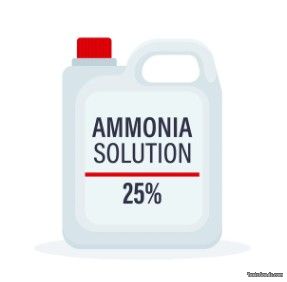Ammonia Toxicity and Why This Common Chemical Is Dangerous
Ammonia is a chemical that many of us encounter in everyday life, often without realizing its potential dangers. It’s widely used in household cleaners, fertilizers, and industrial applications, thanks to its ability to cut through grease and act as a powerful disinfectant. However, ammonia’s toxicity is often underestimated, and its risks extend far beyond its cleaning capabilities. In fact, it’s so hazardous that many experts argue it’s unsafe to keep inside a home, especially in households with children, pets, or individuals with respiratory conditions.
Ammonia (NH₃) is a colorless gas with a sharp, suffocating odor that’s hard to miss. Even at low concentrations, its smell can be overwhelming, but the real danger lies in its ability to cause severe harm to the human body and other living organisms. When inhaled, ammonia reacts with moisture in the respiratory tract to form ammonium hydroxide, a corrosive substance that can damage tissues on contact. This is why even brief exposure to high concentrations of ammonia can lead to burning sensations in the nose, throat, and lungs, along with coughing, shortness of breath, and chest pain.
What Happens When Ammonia Enters the Body?
 The effects of ammonia on the human body depend on the route of exposure. Inhalation is the most common and dangerous form, as it can cause immediate damage to the respiratory system. In severe cases, it can lead to pulmonary edema, a life-threatening condition where fluid fills the lungs. Skin contact with ammonia can cause chemical burns, redness, and blistering, while eye exposure can result in severe irritation, tearing, and even blindness. Ingestion, though rare, is extremely dangerous and can cause burns to the mouth, throat, and stomach, leading to nausea, vomiting, and abdominal pain.
The effects of ammonia on the human body depend on the route of exposure. Inhalation is the most common and dangerous form, as it can cause immediate damage to the respiratory system. In severe cases, it can lead to pulmonary edema, a life-threatening condition where fluid fills the lungs. Skin contact with ammonia can cause chemical burns, redness, and blistering, while eye exposure can result in severe irritation, tearing, and even blindness. Ingestion, though rare, is extremely dangerous and can cause burns to the mouth, throat, and stomach, leading to nausea, vomiting, and abdominal pain.
Ammonia doesn’t just pose a risk to humans. It’s equally harmful to pets, wildlife, and the environment. For example, ammonia fumes can irritate the respiratory systems of animals, and spills can contaminate soil and water, harming plants and aquatic life. Even small amounts of ammonia in water can be toxic to fish, disrupting ecosystems and killing aquatic organisms.
Why Keeping Ammonia at Home Is a Risk
One of the biggest dangers of ammonia is its reactivity with other chemicals. When mixed with bleach, for instance, it produces chloramine gas, which is highly toxic and can cause severe respiratory distress, chest pain, and even death. This makes it particularly risky to store ammonia in homes where other cleaning products are present. Additionally, its strong odor can mask the presence of dangerous concentrations, making it easy to underestimate the level of exposure.
Children and pets are especially vulnerable to ammonia poisoning. Curious kids might accidentally ingest or spill ammonia-based cleaners, while pets, with their sensitive respiratory systems, can be severely affected by fumes. Even adults can suffer from chronic exposure, which has been linked to respiratory issues like asthma and bronchitis.
Symptoms of Ammonia Toxicity
Recognizing the symptoms of ammonia toxicity is crucial for prompt treatment. Common signs include coughing, wheezing, and difficulty breathing after inhalation. Skin contact may cause burns or rashes, while eye exposure can lead to redness, pain, and vision problems. Ingestion can result in severe gastrointestinal distress, including vomiting and abdominal pain. If you suspect ammonia poisoning, seek medical attention immediately.
In conclusion, while ammonia is an effective cleaner and disinfectant, its toxicity makes it a hazardous substance to have in the home. The risks to human health, pets, and the environment far outweigh its benefits for most household uses. By opting for safer alternatives, such as vinegar or baking soda, you can protect your family and the planet from the dangers of ammonia.
Chemical Properties, Specifications, and Effects of Ammonia
| Property | Specification/Value |
|---|---|
| Chemical Name | Ammonia |
| Chemical Formula | NH₃ |
| Molecular Weight | 17.03 g/mol |
| Appearance | Colorless gas |
| Odor | Sharp, pungent, suffocating |
| Concentration | Household cleaners typically contain 5-10% ammonia |
| pH | Highly alkaline (pH ~11-12) |
| Solubility | Highly soluble in water |
| Density | 0.73 kg/m³ (lighter than air) |
| Boiling Point | -33.34°C (-28.01°F) |
| Stability | Stable under normal conditions but reactive with acids and oxidizers |
| Toxicity | Toxic if inhaled, ingested, or absorbed through skin |
| Environmental Impact | Harmful to aquatic life; contributes to air pollution and soil contamination |
References and Sources
- Centers for Disease Control and Prevention (CDC)
The CDC provides detailed information on the health effects of ammonia exposure, including safety guidelines and first aid measures.
URL: https://www.cdc.gov/niosh/ershdb/emergencyresponsecard_29750013.html - National Capital Poison Center
This resource offers practical advice on what to do in case of ammonia poisoning, including symptoms and emergency responses.
URL: https://www.poison.org/articles/ammonia-history-usage-and-safety-221 - Environmental Protection Agency (EPA)
The EPA outlines the environmental impact of ammonia and safer alternatives for household cleaning.
URL: https://nepis.epa.gov/Exe/ZyPURL.cgi?Dockey=20008UJP.txt
